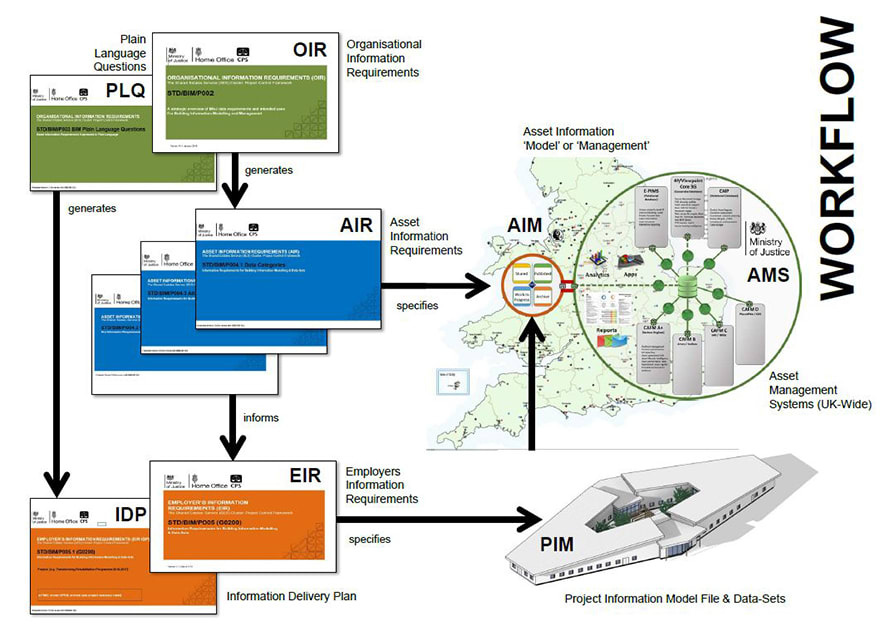BIM2AIM, the Ministry of Justice (MoJ) special interest group, has launched a suite of documents that aim to provide clear and concise instruction and guidance on how to define, procure and deliver Level 2 BIM for its projects.
The guides for employers, which are available here, are currently being reviewed by the government’s BIM Task Group. They will then be shared with other government departments to allow them all to create more clearly defined briefs for asset information on projects they procure.
It is hoped that the redefined documents will assist the MoJ’s supply chain by outlining a clear digital brief from tender and provide sufficient detail to enable data requirements to be packaged, procured and technically assessed on projects.
Compiled collaboratively with input provided by a large number of supply chain partners, including the contractor Wates Group, architect Stride Treglown and consultants Arcadis, WYG and CoBuilder, the suite of BIM-focused policies, procedures and standards are the culmination of six months’ work.
Well known for being an early adopter of BIM, the MoJ has been issuing Employer’s Information Requirements (EIRs) since 2012 and has developed a standardised BIM component library to build virtual designs and models of any building requirement in any part of the MoJ estates family.

A brief wireframe of the Asset Management System
However, as new BIM language and requirements came to the fore, the MoJ has recognised the need to work alongside its supply chain in developing advanced and practical solutions moving forward that more closely meet the needs of industry.
Matthew Watchorn, MoJ head of BIM, said: “I have been impressed and delighted with the response of the volunteers participating in the BIM2AIM Special Interest Group, the success has been beyond our expectations. A genuine client-industry endeavour developing new policy, technical specification and know-how.
“Dismantling, examining and jointly rebuilding the EIR suite of standards from the bottom up was a fundamental moment in the MoJ BIM story and will stand us and other government departments in good stead in making the next phase of BIM a reality for projects going forward. A special thanks is extended to Chris Barker [BIM manager at Wates Construction] for his sterling work as industry lead and his supporting SIG leads.”
Barker added: “Our collaborative approach and willingness to share knowledge and best practice garnered from within our respective roles and organisations was key to us being able to provide the MoJ with a workable much clearer solution to BIM implementation.
“Having worked closely with the MoJ for a number of years, and knowing their appetite and commitment to deliver BIM, we were delighted to be asked to co-chair this special interest group.
“The group is aware that projects now need to utilise and land the documentation in order to help inform future refinements and iterations, but we believe we have been able to help fill a critical gap in current industry literature, and believe we have provided some much-needed clarity on the subject of requesting and procuring asset information models.
“We had a great team, and it just goes to show what industry can achieve if they are given the right terms and environment to cooperate.”
Dismantling, examining and jointly rebuilding the EIR suite of standards from the bottom up was a fundamental moment in the MoJ BIM story and will stand us and other government departments in good stead in making the next phase of BIM a reality for projects going forward.– Matthew Watchorn, MoJ head of BIM
Comments
Comments are closed.












The MoJ BIM team have done a fantastic job and it was great to be able to see the documents develop in a collaborative approach and allowing the whole BIM SIG opportunity to comment on all the documents. I know I made quite a few!
I hope that the work will be shared across all the UK Gov departments to create a harmonised set of BIM guidance.
Adrian
These all look excellent and everyone should be congratulated for sharing them with the wider BIM community.
My only point would be whilst it is to be commended that the UK loD/loI standards are included I cannot see a reference to a singular classification system, is there one being applied ? I appreciate uptake of Uniclass 2015 is limited at present but surely it’s adoption will further support a front to back industry standard suite of documents ? This is a constant issue we struggle with at BDP appreciating the timing of the PAS suite, BS 1192;2014 & the BIM Toolkit means that there’s a degree of alignment necessary and technology is still under development to address the standards.